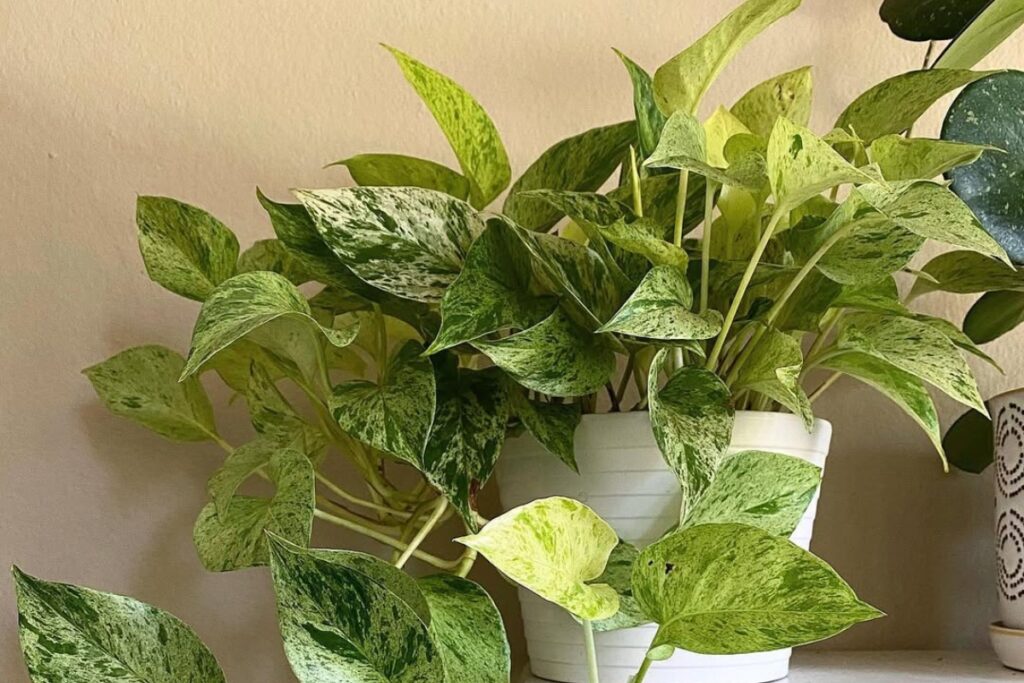Like a graceful dancer in slow motion, your Snow Queen Pothos can transform any indoor space into a cascade of variegated beauty. You’ll find that caring for this stunning houseplant isn’t as challenging as it might seem – with the right knowledge and techniques at your disposal. As botanical expert Dr. Sarah Chen notes, “Success with Snow Queen Pothos comes down to understanding its basic needs and maintaining consistency.” Let’s explore the essential elements that will help your plant thrive.

Contents
The Essential Growing Environment for Snow Queen Pothos
Creating an ideal environment for your Snow Queen Pothos starts with understanding its tropical origins and basic needs. Position your plant in bright, indirect sunlight – direct sun can scorch its distinctive cream-and-green leaves. You’ll want to maintain room temperatures between 65° and 85°F while keeping humidity levels at 50-75%.
To boost humidity:
- Place a pebble tray with water beneath the pot
- Group plants together
- Use a small humidifier nearby
“The key to thriving Snow Queen Pothos is mimicking their natural habitat,” notes botanist Dr. Sarah Chen. “These plants don’t need complex care, just consistent conditions.”
Soil Selection and Watering Techniques

While your Snow Queen Pothos can adapt to various growing media, selecting the right soil mix will greatly boost its growth potential. Choose a well-draining potting mix that combines loamy soil with perlite, maintaining a pH between 6.0 and 6.5.
For watering frequency, let the top 1-2 inches of soil dry between waterings. You’ll want to stick your finger into the soil – if it feels dry at knuckle depth, it’s time to water. Always use pots with drainage holes and empty the saucer after watering to prevent root rot. Remember, it’s better to underwater than overwater your Snow Queen.
Pruning and Maintenance for Healthy Growth
Regular pruning of your Snow Queen Pothos helps promote bushier growth and removes damaged or yellowing foliage. To maintain peak health, implement these pruning techniques every 2-3 months:
- Cut stems just above leaf nodes using clean, sharp scissors
- Remove any yellowed, brown, or damaged leaves at the base
- Trim long, leggy vines to encourage fuller growth
- Clean pruning tools with rubbing alcohol between cuts
For maintenance frequency, inspect your plant weekly for signs of pest damage or disease. Wipe leaves monthly with a damp cloth to remove dust and maintain photosynthesis efficiency. During growing season, remove any struggling vines to redirect energy to healthier growth.
Common Challenges and Troubleshooting Tips
Even the most well-cared-for Snow Queen Pothos can face several common issues that may affect its health and appearance. Watch for yellowing leaves, which often signal overwatering or poor drainage. For effective pest management, inspect your plant weekly for mealybugs and spider mites, treating infestations promptly with neem oil spray. Regular leaf care is essential – wipe leaves monthly with a damp cloth to prevent dust buildup that can block photosynthesis. If you notice brown leaf tips, increase humidity by misting or using a pebble tray. Remember to check soil moisture before watering to prevent root rot.
Propagation Methods and Success Strategies
Since Snow Queen Pothos readily propagates through stem cuttings, you’ll find it’s one of the easiest plants to multiply in your collection. To succeed, select healthy stems with at least 2-3 nodes and make clean cuts just below them.
For ideal root development:
- Place cuttings in water, ensuring nodes are submerged
- Change water every 5-7 days to prevent bacteria
- Wait 2-3 weeks for roots to reach 2-3 inches long
- Transfer to well-draining potting mix
“The key to successful propagation is patience and maintaining consistent conditions,” notes botanist Dr. Sarah Chen. “Keep cuttings in bright, indirect light at 70-75°F for best results.”
